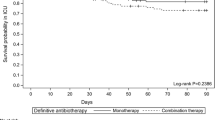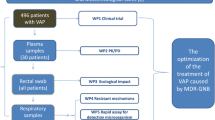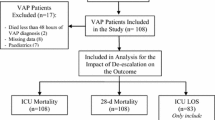Abstract
Objective
To assess the effect on survival of macrolides or fluoroquinolones in intubated patients admitted to the intensive care unit (ICU) with severe community-acquired pneumonia (severe CAP).
Methods
Prospective, observational cohort, multicenter study conducted in 27 ICUs of 9 European countries. Two hundred eighteen consecutive patients requiring invasive mechanical ventilation for an admission diagnosis of CAP were recruited.
Results
Severe sepsis and septic shock were present in 165 (75.7%) patients. Microbiological documentation was obtained in 102 (46.8%) patients. ICU mortality was 37.6% (n = 82). Non-survivors were older (58.6 ± 16.1 vs. 63.4 ± 16.7 years, P < 0.05) and presented a higher score on the simplified Acute Physiology Score II at admission (45.6 ± 15.4 vs. 50.8 ± 17.5, P < 0.05). Monotherapy was given in 43 (19.7%) and combination therapy in 175 (80.3%) patients. Empirical antibiotic therapy was in accordance with the 2007 Infectious Diseases Society of America (IDSA)/American Thoracic Society (ATS) guidelines in 100 (45.9%) patients (macrolides in 46 patients and fluoroquinolones in 54). In this cohort, a Cox regression analysis adjusted by severity identified that macrolide use was associated with lower ICU mortality (hazard ratio, HR 0.48, confidence intervals, 95% CI 0.23–0.97, P = 0.04) when compared to the use of fluoroquinolones. When more severe patients presenting severe sepsis and septic shock were analyzed (n = 92), similar results were obtained (HR 0.44, 95% CI 0.20–0.95, P = 0.03).
Conclusions
Patients with severe community-acquired pneumonia had a low adherence with the 2007 IDSA/ATS guidelines. Combination therapy with macrolides should be preferred in intubated patients with severe CAP.



Similar content being viewed by others
References
Angus DC, Linde-Zwirble WT, Lidicker J, Clermont G, Carcillo J, Pinsky MR (2001) Epidemiology of severe sepsis in the United States: analysis of incidence, outcome, and associated costs of care. Crit Care Med 29:1303–1310
Bodi M, Rodriguez A, Sole-Violan J, Gilavert MC, Garnacho J, Blanquer J, Jimenez J, de la Torre MV, Sirvent JM, Almirall J, Doblas A, Badia JR, Garcia F, Mendia A, Jorda R, Bobillo F, Valles J, Broch MJ, Carrasco N, Herranz MA, Rello J (2005) Antibiotic prescription for community-acquired pneumonia in the intensive care unit: impact of adherence to Infectious Diseases Society of America guidelines on survival. Clin Infect Dis 41:1709–1716
Shorr AF, Bodi M, Rodriguez A, Sole-Violan J, Garnacho-Montero J, Rello J, for the CAPUCI Study Investigators (2006) Impact of antibiotic guideline compliance on duration of mechanical ventilation in critically ill patients with community-acquired pneumonia. Chest 130:93–100
Rodríguez A, Mendia A, Sirvent JM, Barcenilla F, de la Torre-Prados MV, Solé-Violán J, Rello J, CAPUCI Study Group (2007) Combination antibiotic therapy improves survival in patients with community-acquired pneumonia and shock. Crit Care Med 35:1493–1498
Mandell LA, Wunderink RG, Anzueto A, Bartlett JG, Campbell GD, Dean NC, Dowell SF, File TM Jr, Musher DM, Niederman MS, Torres A, Whitney CG (2007) Infectious Diseases Society of America; American Thoracic Society. Infectious Diseases Society of America/American Thoracic Society consensus guidelines on the management of community-acquired pneumonia in adults. Clin Infect Dis 44(Suppl 2):S27–S72
Restrepo MI, Mortensen EM, Waterer GW, Wunderink RG, Coalson JJ, Anzueto A (2009) Impact of macrolide therapy on mortality for patients with severe sepsis due to pneumonia. Eur Respir J 33:153–159
Giamarellos-Bourboulis EJ, Adamis T, Laoutaris G, Sabracos L, Koussoulas V, Mouktaroudi M, Perrea D, Karayannacos PE, Giamarellou H (2004) Immunomodulatory clarithromycin treatment of experimental sepsis and acute pyelonephritis caused by multidrug-resistant pseudomonas aeruginosa. Antimicrob Agents Chemother 48:93–99
Garcia Vazquez E, Mensa J, Martinez JA, Marcos MA, Puig J, Ortega M, Torres A (2005) Lower mortality among patients with community-acquired pneumonia treated with a macrolide plus a beta-lactam agent versus a beta-lactam agent alone. Eur J Clin Microbiol Infect Dis 24:190–195
Houck PM, MacLehose RF, Niederman MS, Lowery JK (2001) Empiric antibiotic therapy and mortality among medicare pneumonia inpatients in ten western states: 1993, 1995, and 1997. Chest 119:1420–1426
Mortensen EM, Restrepo M, Anzueto A, Pugh J (2004) Effects of guideline-concordant antimicrobial therapy on mortality among patients with community-acquired pneumonia. Am J Med 117:726–731
Koulenti D, Lisboa T, Brun-Buisson C, Krueger W, Macor A, Sole-Violan J, Diaz E, Topeli A, DeWaele J, Carneiro A, Martin-Loeches I, Armaganidis A, Rello J (2009) The spectrum of practice in the diagnosis of nosocomial pneumonia in patients requiring mechanical ventilation in European ICUs. Crit Care Med 37:2360–2368
de Castro FR, Torres A (2003) Optimizing treatment outcomes in severe community-acquired pneumonia. Am J Respir Med 2:39–54
Rello J, Bodi M, Mariscal D, Navarro M, Diaz E, Gallego M, Valles J (2003) Microbiological testing and outcome of patients with severe community-acquired pneumonia. Chest 123:174–180
Bartlett JG, Dowell SF, Mandell LA, File TM Jr, Musher DM, Fine MJ (2000) Practice guidelines for the management of community-acquired pneumonia in adults. Infectious Diseases Society of America. Clin Infect Dis 31:347–382
Levy MM, Fink MP, Marshall JC, Abraham E, Angus D, Cook D, Cohen J, Opal SM, Vincent JL, Ramsay G (2003) 2001 SCCM/ESICM/ACCP/ATS/SIS.CCM/ESICM/ACCP/ATS/SIS International Sepsis Definitions Conference. Crit Care Med 31:1250-1256
Bone RC (1996) Why sepsis trials fail. JAMA 276:565–566
Dambrava PG, Torres A, Vallès X, Mensa J, Marcos MA, Peñarroja G, Camps M, Estruch R, Sánchez M, Menéndez R, Niederman MS (2008) Adherence to guidelines’ empirical antibiotic recommendations and community-acquired pneumonia outcome. Eur Respir J 32:892–901
Weiss K, Low DE, Cortes L, Beaupre A, Gauthier R, Gregoire P, Legare M, Nepveu F, Thibert D, Tremblay C, Tremblay J (2004) Clinical characteristics at initial presentation and impact of dual therapy on the outcome of bacteremic Streptococcus pneumoniae pneumonia in adults. Can Respir J 11:589–593
Sollet JP (2006) Respiratory tract infections: at-risk patients, who are they? Implications for their management with levofloxacin. Int J Antimicrob Agents 28 Suppl 2:S113–S114
Baddour LM, Yu VL, Klugman KP, Feldman C, Ortkvist A, Rello J, Morris AJ, Luna CM, Snydman DR, Ko WC, Chedid BF, Hui DS, Andremont A, Chiou CCC, the International Pneumococcal Study Group (2004) Combination antibiotic therapy may lower mortality in severely ill patients with Streptococcus pneumoniae bacteremia. Am J Respir Crit Care Med 170:400–404
Martinez JA, Horcajada JP, Almela M, Marco F, Soriano A, Garcia E, Marco MA, Torres A, Mensa J (2003) Addition of a macrolide to a beta-lactam-based empirical antibiotic regimen is associated with lower in-hospital mortality for patients with bacteremic pneumococcal pneumonia. Clin Infect Dis 36:389–395
Waterer GW, Somes GW, Wunderink RG (2001) Monotherapy may be suboptimal for severe bacteremic pneumococcal pneumonia. Arch Intern Med 161:1837–1842
Tessmer A, Welte T, Martus P, Schnoor M, Marre R, Suttorp N (2009) Impact of intravenous β-lactam/macrolide versus β-lactam monotherapy on mortality in hospitalized patients with community-acquired pneumonia. J Antimicrob Chemother 63:1025–1033
Tamaoki J, Kadota J, Takizawa H (2004) Clinical implications of the immunomodulatory effects of macrolides. Am J Med 117(Suppl 9A):5S–11S
Healy DP (2007) Macrolide immunomodulation of chronic respiratory diseases. Curr Infect Dis Rep 9:7–13
Vanaudenaerde BM, Wuyts WA, Geudens N, Dupont LJ, Schoofs K, Smeets S, Van Raemdonck DE, Verleden GM (2007) Macrolides inhibit IL17-induced IL8 and 8-isoprostane release from human airway smooth muscle cells. Am J Transplant 7:76–82
Wunderink RG (2009) Adjunctive therapy in community-acquired pneumonia. Semin Respir Crit Care Med 30:146–153
Brown RB, Iannini P, Gross P, Kunkel M (2003) Impact of initial antibiotic choice on clinical outcomes in community-acquired pneumonia: análisis of a hospital claims-made database. Chest 123:1503–1511
Gleason PP, Meehan TP, Fine JM, Galusha DH, Fine MJ (1999) Associations between initial antimicrobial therapy and medical outcomes for hospitalized elderly patients with pneumonia. Arch Intern Med 159:2562–2572
Metersky ML, Ma A, Houck PM, Bratzler DW (2007) Antibiotics for bacteremic pneumonia: improved outcomes with macrolides but not fluoroquinolones. Chest 131:466–473
Mortensen EM, Restrepo MI, Anzueto A, Pugh J (2006) The impact of empiric antimicrobial therapy with a β-lactam and fluoroquinolone on mortality for patients hospitalized with severe pneumonia. Crit Care 10:R8
Capelastegui A, Espana PP, Quintana JM, Areitio I, Gorordo I, Egurrola M, Bilbao A (2006) Validation of a predictive rule for the management of community-acquired pneumonia. Eur Respir J 27:151–157
Dremsizov T, Clermont G, Kellum JA, Kalassian KG, Fine MJ, Angus DC (2006) Severe sepsis in community-acquired pneumonia: when does it happen, and do systemic inflammatory response syndrome criteria help predict course? Chest 129:968–978
Shorr AF, Wunderink R (2008) There is no “CAP” on the importance of community acquired pneumonia in the ICU. Chest 133:590–592
Roberts JA, Lipman J (2006) Antibacterial dosing in intensive care: pharmacokinetics, degree of disease, and pharmacodynamics of sepsis. Clin Pharmacokinet 45:755–773
Pea F, Viale P (2009) Bench-to-bedside review: appropriate antibiotic therapy in severe sepsis and septic shock—does the dose matter? Crit Care 13:214
Roberts JA, Lipman J, Blot S, Rello J (2008) Better outcomes through continuous infusion of time-dependent antibiotics to critically ill patients? Curr Opin Crit Care 14:390–396
Murphy TF (2008) Placebo-controlled trials of treatments for community acquired pneumonia: review of the literature and discussion of feasibility and potential value. Clin Infect Dis 47:S145–S149
Acknowledgments
The EU-VAP/CAP Study is endorsed by the European Critical Care Research Network (ECCRN). This study has been supported in part by grants from CIBER Enfermedades Respiratorias (CIBERES 37706/06/0036) by Carlos III Health Institute and FISS 04/1500. Dr. Restrepo is supported by a Department of Veteran Affairs Veterans Integrated Service Network 17 new faculty grant and National Health Institute grant KL2 RR025766.
Conflict of interest statement
The authors declare no conflict of interest regarding this manuscript.
Author information
Authors and Affiliations
Corresponding author
Additional information
For the EU-VAP/CAP Study Group.
This article is discussed in the editorial available at: doi:10.1007/s00134-009-1734-7.
Appendix
Appendix
The EU-VAP/CAP Study Group: Djilali Annane (Raymond Poincaré University Hospital, Garches, France), Rosario Amaya-Villar (Virgen de Rocio University Hospital, Seville, Spain), Apostolos Armaganidis (Attikon University Hospital, Athens, Greece), Stijn Blot (Ghent University Hospital, Ghent, Belgium), Christian Brun-Buisson (Henri-Mondor University Hospital, Paris, France), Antonio Carneiro (Santo Antonio Hospital, Porto, Portugal), Maria Deja (Charité University Hospital, Berlin, Germany), Jan DeWaele (Ghent University Hospital, Ghent, Belgium), Emili Diaz (Joan XIII University Hospital, Tarragona, Catalonia), George Dimopoulos (Attikon University Hospital and Sotiria Hospital, Athens, Greece), Silvano Gardellino (Cardinal Massaia Hospital, Asti, Italy), Jose Garnacho-Montero (Virgen de Rocio University Hospital, Seville, Spain), Mustafa Guven (Erciyes University Hospital, Kayseri, Turkey), Apostolos Komnos (Larisa Hospital, Larisa, Greece), Despona Koulenti (Attikon University Hospital, Athens, Greece and Rovira i Virgili University, Tarragona, Spain), Wolfgang Krueger (Tuebingen University Hospital, Tuebingen, Germany and Constance Hospital, Constance, Germany), Thiago Lisboa (Joan XIII University Hospital, Tarragona, Catalonia and CIBER Enfermedades Respiratorias), (Antonio Macor, Amedeo di Savoia Hospital, Torino, Italy), Emilpaolo Manno (Maria Vittoria Hospital, Torino, Italy), R. Mañez (Bellvitge University Hospital, Barcelona, Catalonia), Brian Marsh (Mater Misericordiae University Hospital, Dublin, Ireland), Claude Martin (Nord University Hospital, Marseille, France), Ignacio Martin-Loeches (Mater Misericordiae University Hospital, Dublin, Ireland), Pavlos Myrianthefs (KAT Hospital, Athens, Greece), M. Nawynck (St Jan Hospital, Brugges, Belgium), Laurent Papazian (Sainte Marguerite University Hospital, Marseille, France), Christian Putensen (Bonn University Hospital, Bonn, Germany), Bernard Regnier (Claude Bernard University Hospital, Paris, France), Jordi Rello (Joan XIII University Hospital, Tarragona, Catalonia), Jordi Sole-Violan (Dr. Negrin University Hospital, Gran Canarias, Spain), Giuseppe Spina (Mauriziano Umberto I Hospital, Torino, Italy), Arzu Topeli (Hacettepe University Hospital, Ankara, Turkey), Hermann Wrigge (Bonn University Hospital, Bonn, Germany).
Rights and permissions
About this article
Cite this article
Martin-Loeches, I., Lisboa, T., Rodriguez, A. et al. Combination antibiotic therapy with macrolides improves survival in intubated patients with community-acquired pneumonia. Intensive Care Med 36, 612–620 (2010). https://doi.org/10.1007/s00134-009-1730-y
Received:
Accepted:
Published:
Issue Date:
DOI: https://doi.org/10.1007/s00134-009-1730-y




